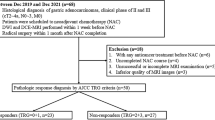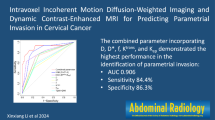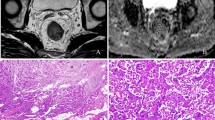Abstract
Purpose
To investigate the potential of intravoxel incoherent motion diffusion-weighted imaging (IVIM) for preoperative prediction of lymphovascular invasion (LVI) in gastric cancer (GC).
Methods
This study prospectively enrolled 90 patients (62 males, 28 females, 60.79 ± 9.99 years old) who received radical gastrostomy. Abdominal MRI examinations including IVIM were performed within 1 week before surgery. Patients were divided into LVI-positive and -negative group according to pathological diagnosis after surgery. The apparent diffusion coefficient (ADC) and IVIM parameters, including true diffusion coefficient (D), pseudodiffusion coefficient (D*), and pseudodiffusion fraction (f), were compared between the two groups. The relationship between MRI parameters and LVI was studied by Spearman’s correlation analysis. Multivariable logistic regression analysis was used to screen independent predictors of LVI. Receiver-operating characteristic curve analyses were applied to evaluate the efficacy.
Results
The ADC, D in LVI-positive group were lower, whereas tumor thickness and f parameter in LVI-positive group were higher than those in LVI-negative group, and they were statistically correlated with LVI (p < 0.05). D, f and tumor thickness were independent risk factors of LVI. The area under the curve of ADC, D, f, thickness, and the combined parameter (D + f + thickness) were 0.667, 0.754, 0.695, 0.792, and 0.876, respectively. The combined parameter demonstrated higher efficacy than any other parameters (p < 0.05).
Conclusion
The ADC, D, and f can effectively distinguish LVI status of GC. The D, f and thickness were independent predictors. The combination of the three predictors further improved the efficacy.





Similar content being viewed by others
Data availability
The datasets used and analyzed during the current study are available from the corresponding author on reasonable request.
References
Sung H, Ferlay J, Siegel RL et al. (2021) Global Cancer Statistics 2020: GLOBOCAN Estimates of Incidence and Mortality Worldwide for 36 Cancers in 185 Countries. CA Cancer J Clin 71:209-249. https://doi.org/10.3322/caac.21660.
Cao W, Chen HD, Yu YW et al. (2021) Changing profiles of cancer burden worldwide and in China: a secondary analysis of the global cancer statistics 2020. Chin Med J (Engl) 134:783-791. https://doi.org/10.1097/CM9.0000000000001474.
Papageorge MV, de Geus SWL, Zheng J et al. (2021) The Discordance of Clinical and Pathologic Staging in Locally Advanced Gastric Adenocarcinoma. J Gastrointest Surg 25:1363-1369. https://doi.org/10.1007/s11605-021-04993-4.
Smyth EC, Nilsson M, Grabsch HI et al. (2020) Gastric cancer. Lancet 396:635-648. https://doi.org/10.1016/S0140-6736(20)31288-5.
Amin MB, Greene FL, Edge SB et al. (2017) The eighth edition AJCC cancer staging manual: Continuing to build a bridge from a population-based to a more "personalized" approach to cancer staging. CA Cancer J Clin 67:93–99. https://doi.org/10.3322/caac.21388.
Fujita K, Kanda M, Ito S et al. (2020) Association between Lymphovascular Invasion and Recurrence in Patients with pT1N+ or pT2-3N0 Gastric Cancer: a Multi-institutional Dataset Analysis. J Gastric Cancer 20:41-49. https://doi.org/10.5230/jgc.2020.20.e3.
Choi S, Song JH, Lee S et al. (2021) Lymphovascular Invasion: Traditional but Vital and Sensible Prognostic Factor in Early Gastric Cancer. Ann Surg Oncol 28:8928-8935. https://doi.org/10.1245/s10434-021-10224-6.
Lu J, Dai Y, Xie JW et al. (2019) Combination of lymphovascular invasion and the AJCC TNM staging system improves prediction of prognosis in N0 stage gastric cancer: results from a high-volume institution. BMC Cancer 19:216. https://doi.org/10.1186/s12885-019-5416-8.
Hirabayashi S, Kosugi S, Isobe Y et al. (2014) Development and external validation of a nomogram for overall survival after curative resection in serosa-negative, locally advanced gastric cancer. Ann Oncol 25:1179-1184. https://doi.org/10.1093/annonc/mdu125.
Padera TP, Kadambi A, di Tomaso E et al. (2002) Lymphatic metastasis in the absence of functional intratumor lymphatics. Science 296:1883–1886. https://doi.org/10.1126/science.1071420.
Meng Y, Huang X, Liu J et al. (2021) A Novel Nomogram for Individually Predicting of Vascular Invasion in Gastric Cancer. echnol Cancer Res Treat 20:15330338211004924. https://doi.org/10.1177/15330338211004924.
Ma Z, Liang C, Huang Y et al. (2017) Can lymphovascular invasion be predicted by preoperative multiphasic dynamic CT in patients with advanced gastric cancer? Eur Radiol 27:3383-3391. https://doi.org/10.1007/s00330-016-4695-6.
Zhang Y, Yu J. The role of MRI in the diagnosis and treatment of gastric cancer. Diagn Interv Radiol 2020;26(3):176-182.
Li Q, Feng QX, Qi L et al (2022) Prognostic aspects of lymphovascular invasion in localized gastric cancer: new insights into the radiomics and deep transfer learning from contrast-enhanced CT imaging. Abdom Radiol (NY) 47:496-507. https://doi.org/10.1007/s00261-021-03309-z.
Chen X, Yang Z, Yang J et al. (2020) Radiomics analysis of contrast-enhanced CT predicts lymphovascular invasion and disease outcome in gastric cancer: a preliminary study. Cancer Imaging 20 (1):24. https://doi.org/10.1186/s40644-020-00302-5.
Liu S, Wang H, Guan W et al. (2015) Preoperative apparent diffusion coefficient value of gastric cancer by diffusion-weighted imaging: Correlations with postoperative TNM staging. J Magn Reson Imaging 42:837-43. https://doi.org/10.1002/jmri.24841.
Le Bihan D (2013) Apparent diffusion coefficient and beyond: what diffusion MR imaging can tell us about tissue structure. Radiology 268:318–322. https://doi.org/10.1148/radiol.13130420.
Le Bihan D, Breton E, Lallemand D et al. (1988) Separation of diffusion and perfusion in intravoxel incoherent motion MR imaging. Radiology 168:497-505. https://doi.org/10.1148/radiology.168.2.3393671.
Sun J, Wu G, Shan F et al. (2019) The Value of IVIM DWI in Combination with Conventional MRI in Identifying the Residual Tumor After Cone Biopsy for Early Cervical Carcinoma. Acad Radiol 26:1040-1047. https://doi.org/10.1016/j.acra.2018.09.027.
Yu XP, Wen L, Hou J et al. (2016) Discrimination between Metastatic and Nonmetastatic Mesorectal Lymph Nodes in Rectal Cancer Using Intravoxel Incoherent Motion Diffusion-weighted Magnetic Resonance Imaging. Acad Radiol 23:479-485. https://doi.org/10.1016/j.acra.2015.12.013.
Klaassen R, Steins A, Gurney-Champion OJ et al. (2020) Pathological validation and prognostic potential of quantitative MRI in the characterization of pancreas cancer: preliminary experience. Mol Oncol 14:2176-2189. https://doi.org/10.1002/1878-0261.12688.
Zeng Q, Hong Y, Cheng J et al. (2021) Quantitative study of preoperative staging of gastric cancer using intravoxel incoherent motion diffusion-weighted imaging as a potential clinical index. Eur J Radiol 141:109627. https://doi.org/10.1016/j.ejrad.2021.109627.
Song XL, Kang HK, Jeong GW et al. (2016) Intravoxel incoherent motion diffusion-weighted imaging for monitoring chemotherapeutic efficacy in gastric cancer. World J Gastroenterol 22:5520-5531.
Zhu Y, Jiang Z, Wang B et al. (2022) Quantitative Dynamic-Enhanced MRI and Intravoxel Incoherent Motion Diffusion-Weighted Imaging for Prediction of the Pathological Response to Neoadjuvant Chemotherapy and the Prognosis in Locally Advanced Gastric Cancer. Front Oncol 12:841460. https://doi.org/10.3389/fonc.2022.841460.
Guiu B, Petit JM, Capitan V et al. (2012) Intravoxel incoherent motion diffusion-weighted imaging in nonalcoholic fatty liver disease: a 3.0-T MR study Hillon P, Krausé D, Cercueil JP.. Radiology 265:96-103. https://doi.org/10.1148/radiol.12112478.
Cohen AD, Schieke MC, Hohenwalter MD et al. (2015) The effect of low b-values on the intravoxel incoherent motion derived pseudodiffusion parameter in liver. Magn Reson Med 73:306-311. https://doi.org/10.1002/mrm.25109.
Koh DM, Collins DJ, Orton MR.(2011) Intravoxel incoherent motion in body diffusion-weighted MRI: reality and challenges. AJR Am J Roentgenol 196:1351-1361. https://doi.org/10.2214/AJR.10.5515.
Zhang MC, Li XH, Huang SY et al. (2019) IVIM with fractional perfusion as a novel biomarker for detecting and grading intestinal fibrosis in Crohn's disease. Eur Radiol 29:3069-3078. https://doi.org/10.1007/s00330-018-5848-6.
Lu B, Yang X, Xiao X et al. (2018) Intravoxel Incoherent Motion Diffusion-Weighted Imaging of Primary Rectal Carcinoma: Correlation with Histopathology. Med Sci Monit 24:2429-2436. https://doi.org/10.12659/msm.908574. 20
Jalnefjord O, Montelius M, Starck G et al. (2019) Optimization of b-value schemes for estimation of the diffusion coefficient and the perfusion fraction with segmented intravoxel incoherent motion model fitting. Magn Reson Med 82:1541-1552. https://doi.org/10.1002/mrm.27826.
Burgart LJ, Chopp WV, Jain D et al. (2021) Protocol for the Examination of Specimens From Patients With Carcinoma of the Stomach (Version: Stomach 4.2.0.0) [EB/OL]. Northfield: College of American Pathologists. Posting date: June 2021, accessing date: 1st March 2022. https://documents.cap.org/protocols/Stomach_4.2.0.0.REL_CAPCP.pdf
Liu S, Guan W, Wang H et al. (2014) Apparent diffusion coefficient value of gastric cancer by diffusion-weighted imaging: correlations with the histological differentiation and Lauren classification. Eur J Radiol 83:2122-2128. https://doi.org/10.1016/j.ejrad.2014.09.021.
Stocker D, Manoliu A, Becker AS et al. (2018) Image Quality and Geometric Distortion of Modern Diffusion-Weighted Imaging Sequences in Magnetic Resonance Imaging of the Prostate. Invest Radiol 53:200-206. https://doi.org/10.1097/RLI.0000000000000429.
Xu Y, Xu Q, Sun H et al. (2018) Could IVIM and ADC help in predicting the KRAS status in patients with rectal cancer? Eur Radiol 28:3059-3065. https://doi.org/10.1007/s00330-018-5329-y.
Lee EY, Yu X, Chu MM et al. (2014) Perfusion and diffusion characteristics of cervical cancer based on intraxovel incoherent motion MR imaging-a pilot study. Eur Radiol 24:1506-1513. https://doi.org/10.1007/s00330-014-3160-7.
Andreou A, Koh DM, Collins DJ et al. (2013)Measurement reproducibility of perfusion fraction and pseudodiffusion coefficient derived by intravoxel incoherent motion diffusion-weighted MR imaging in normal liver and metastases. Eur Radiol 23:428-434. https://doi.org/10.1007/s00330-012-2604-1.
Jerome NP, Miyazaki K, Collins DJ et al. (2017) Repeatability of derived parameters from histograms following non-Gaussian diffusion modelling of diffusion-weighted imaging in a paediatric oncological cohort. Eur Radiol 27:345-353. https://doi.org/10.1007/s00330-016-4318-2.
Li J, Wang Y, Wang R et al. (2022) Spectral CT for preoperative prediction of lymphovascular invasion in resectable gastric cancer: With external prospective validation. Front Oncol 12:942425. https://doi.org/10.3389/fonc.2022.942425.
Li J, Fang M, Wang R et al. (2018) Diagnostic accuracy of dual-energy CT-based nomograms to predict lymph node metastasis in gastric cancer. Eur Radiol 28:5241-5249. https://doi.org/10.1007/s00330-018-5483-2.
Funding
This work was supported by [Henan Provincial Medical Science and Technology Project (SBGJ202003011)], [National Natural Science Foundation of China (Nos. 82202146, 82271979)], [Special funding of Henan Health Science and Technology Innovation Talent Project (Nos. YXKC2020011, YXKC2021054)].
Author information
Authors and Affiliations
Contributions
Conceptualization: JL, JQ; Methodology: HZ, SX; Formal analysis and investigation: JL, LY, YW; Writing—original draft preparation: JL, YW; Writing—review and editing: JQ, XC; Funding acquisition: JL, JQ; Resources: JQ; Supervision: XC. All authors read and approved the final manuscript.
Corresponding author
Ethics declarations
Competing interests
The authors did not receive support from any organization for the submitted work.
Ethical approval
The study was approved by the institutional review board of the Affiliated Cancer Hospital of Zhengzhou University (Henan Cancer Hospital, Zhengzhou, China) in accordance with the Declaration of Helsinki. All methods were carried out in accordance with relevant guidelines and regulations.
Informed consent
Written informed consent was obtained from all individual patients included in the study (NCT04028375).
Additional information
Publisher's Note
Springer Nature remains neutral with regard to jurisdictional claims in published maps and institutional affiliations.
Rights and permissions
Springer Nature or its licensor (e.g. a society or other partner) holds exclusive rights to this article under a publishing agreement with the author(s) or other rightsholder(s); author self-archiving of the accepted manuscript version of this article is solely governed by the terms of such publishing agreement and applicable law.
About this article
Cite this article
Li, J., Yan, Ll., Zhang, Hk. et al. Application of intravoxel incoherent motion diffusion-weighted imaging for preoperative knowledge of lymphovascular invasion in gastric cancer: a prospective study. Abdom Radiol 48, 2207–2218 (2023). https://doi.org/10.1007/s00261-023-03920-2
Received:
Revised:
Accepted:
Published:
Issue Date:
DOI: https://doi.org/10.1007/s00261-023-03920-2




